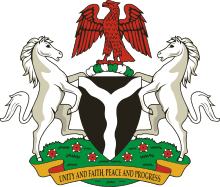History of the Yoruba people
Part of a series on the |
||||||||||||||||||
|---|---|---|---|---|---|---|---|---|---|---|---|---|---|---|---|---|---|---|
| History of Nigeria | ||||||||||||||||||
 | ||||||||||||||||||
| Timeline | ||||||||||||||||||
|
||||||||||||||||||
| See also | ||||||||||||||||||
|
| ||||||||||||||||||
The documented history of the Yoruba people begins with the Oyo Empire, which became dominant in the early 17th century. Older traditions of the formerly dominant Ile-Ife kingdom are sparse and unreliable.
Before Oyo
The peoples who lived in Yorubaland, at least by the seventh century BC, were not initially known as the Yoruba, although they shared a common ethnicity and language group. The historical Yoruba develop in situ, out of earlier (Mesolithic) Volta-Niger populations, by the 1st millennium BC.
Archaeologically, the settlement at Iife can be dated to the 4th century BC, with urban structures appearing in the 12th century (the urban phase of Iife before the rise of Oyo, ca. 1100-1600, is sometimes described as a "golden age" of Iife).
Oyo Empire
Ife was surpassed by the Oyo Empire as the dominant Yoruba military and political power between 1600 and 1800 AD. The nearby kingdom of Benin was also a powerful force between 1300 and 1850.
Most of the city states were controlled by Obas, elected priestly monarchs, and councils made up of Oloyes, recognised leaders of royal, noble, and often even common descent, who joined them in ruling over the kingdoms through a series of guilds and cults. Different states saw differing ratios of power between the kingship and the chiefs' council. Some, such as Oyo, had powerful, autocratic monarchs with almost total control, while in others such as the Ijebu city-states, the senatorial councils were supreme and the Ọba served as something of a figurehead.
In all cases, however, Yoruba monarchs were subject to the continuing approval of their constituents as a matter of policy, and could be easily compelled to abdicate for demonstrating dictatorial tendencies or incompetence. The order to vacate the throne was usually communicated through an aroko or symbolic message, which usually took the form of parrots' eggs delivered in a covered calabash bowl by the senators.
Modern history

The Yoruba eventually established a federation of city-states under the political ascendancy of the city state of Oyo, located on the Northern fringes of Yorubaland in the savanna plains between the forests of present Southwest Nigeria and the Niger River.
Following a Jihad led by Uthman Dan Fodio and a rapid consolidation of the Hausa city states of contemporary northern Nigeria, the Fulani Sokoto Caliphate invaded and annexed the buffer Nupe Kingdom. It then began to advance southwards into Ọyọ lands. Shortly afterwards, its armies overran the Yoruba military capital of Ilorin, and then sacked and destroyed Ọyọ-Ile, the royal seat of the Ọyọ Empire.
Following this, Ọyọ-Ile was abandoned, and the Ọyọ retreated south to the present city of Oyo (formerly known as "Ago d'Oyo", or "Oyo Atiba") in a forested region where the cavalry of the Sokoto Caliphate was less effective. Further attempts by the Sokoto Caliphate to expand southwards were checked by the Yoruba who had rallied in defence under the military leadership of the ascendant Ibadan clan, which rose from the old Oyo Empire, and of the Ijebu city-states.
However, the Oyo hegemony had been dealt a mortal blow. The other Yoruba city-states broke free of Oyo dominance, and subsequently became embroiled in a series of internecine conflicts that soon metamorphosed into a full scale civil war. These events weakened the southern Yorubas in their resistance to British colonial and military invasions. In 1960, greater Yorubaland was subsumed into the Federal Republic of Nigeria.[1] The historical records of the Yoruba, which became more accessible in the nineteenth century with the more permanent arrival of the Europeans, tell of heavy Jihad raids by the mounted Fulani warriors of the north as well as of endemic intercity warfare amongst the Yoruba themselves. Archaeological evidence of the greatness of their ancient civilization in the form of, amongst other things, impressive architectural achievements like Sungbo's Eredo that are centuries old, nevertheless abound.[2]
References
| Wikimedia Commons has media related to Yoruba. |
Bibliography
- Adebayo Kayode "After Oduduwa"???
- Akintoye, Stephen Adebanji: A History of the Yoruba People, Dakar, 2010.
- Idowu, Bolaji E. : "Olodumare: God in Yoruba Belief" Wazobia, New York, NY 1994 ISBN 1-886832-00-5.
- Idowu, Bolaji: Olodumare: God in Yoruba Belief, London 1962.
- Johnson, Samuel: History of the Yorubas, London 1921.
- Lucas, Jonathan Olumide "The Religion of the Yorubas", Lagos 1948.
- Lange, Dierk: "The dying and the rising God in the New Year Festival of Ife", in: Lange, Ancient Kingdoms of West Africa, Dettelbach 2004, pp. 343–376.
- --: "Origin of the Yoruba and the 'Lost Tribes of Israel'", Anthropos, 106 (2011), 579-596.
- Law, Robin: The Oyo Empire, c. 1600 – c. 1836, Oxford 1977.
- Smith, Robert: Kingdoms of the Yoruba, 1st ed. 1969, 3rd ed. London 1988.